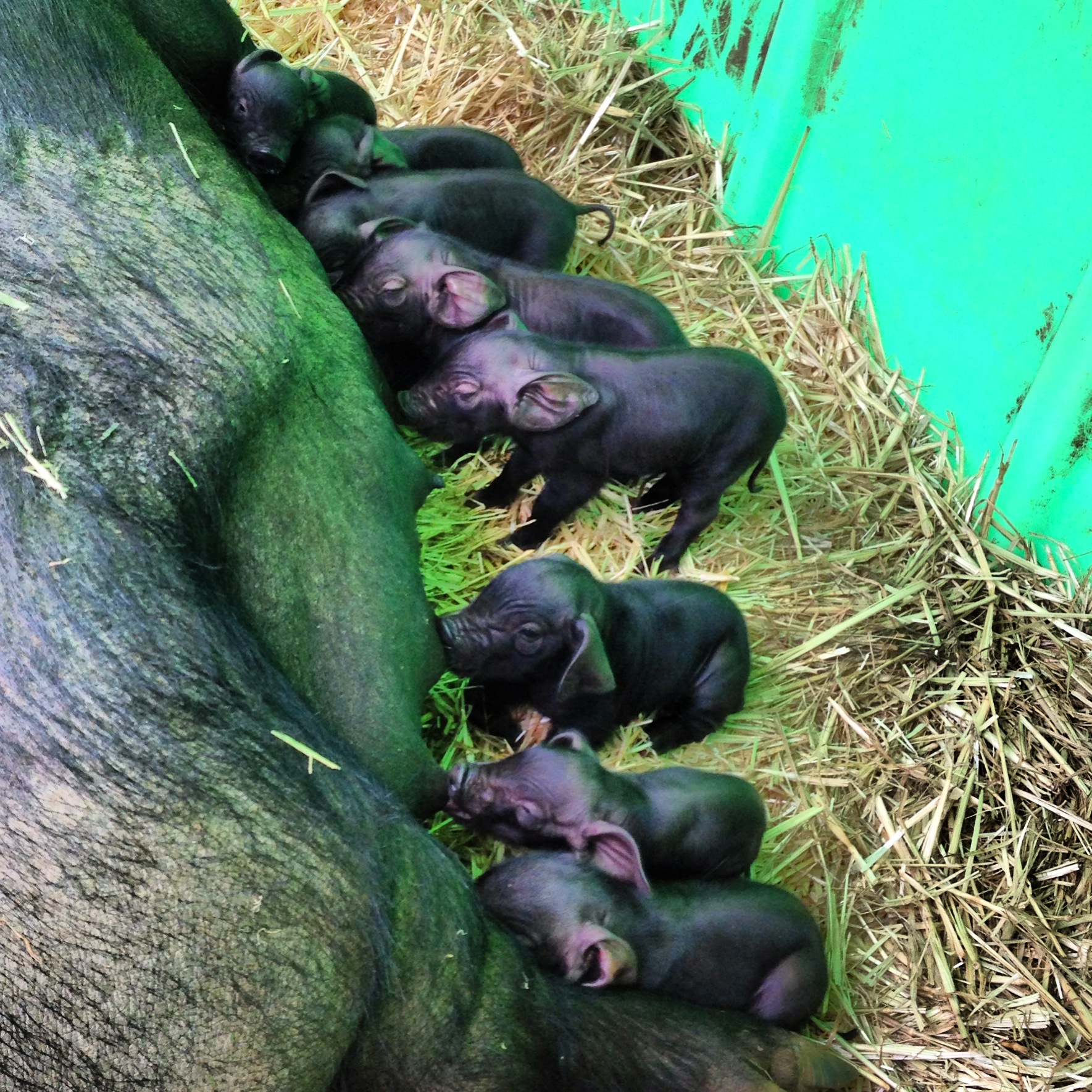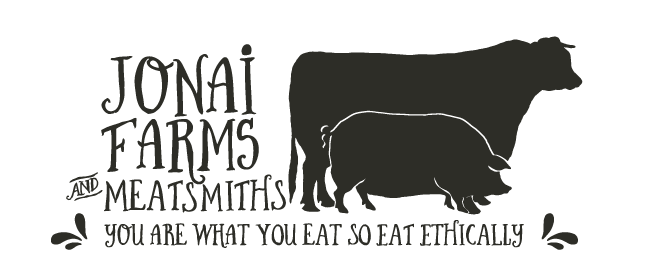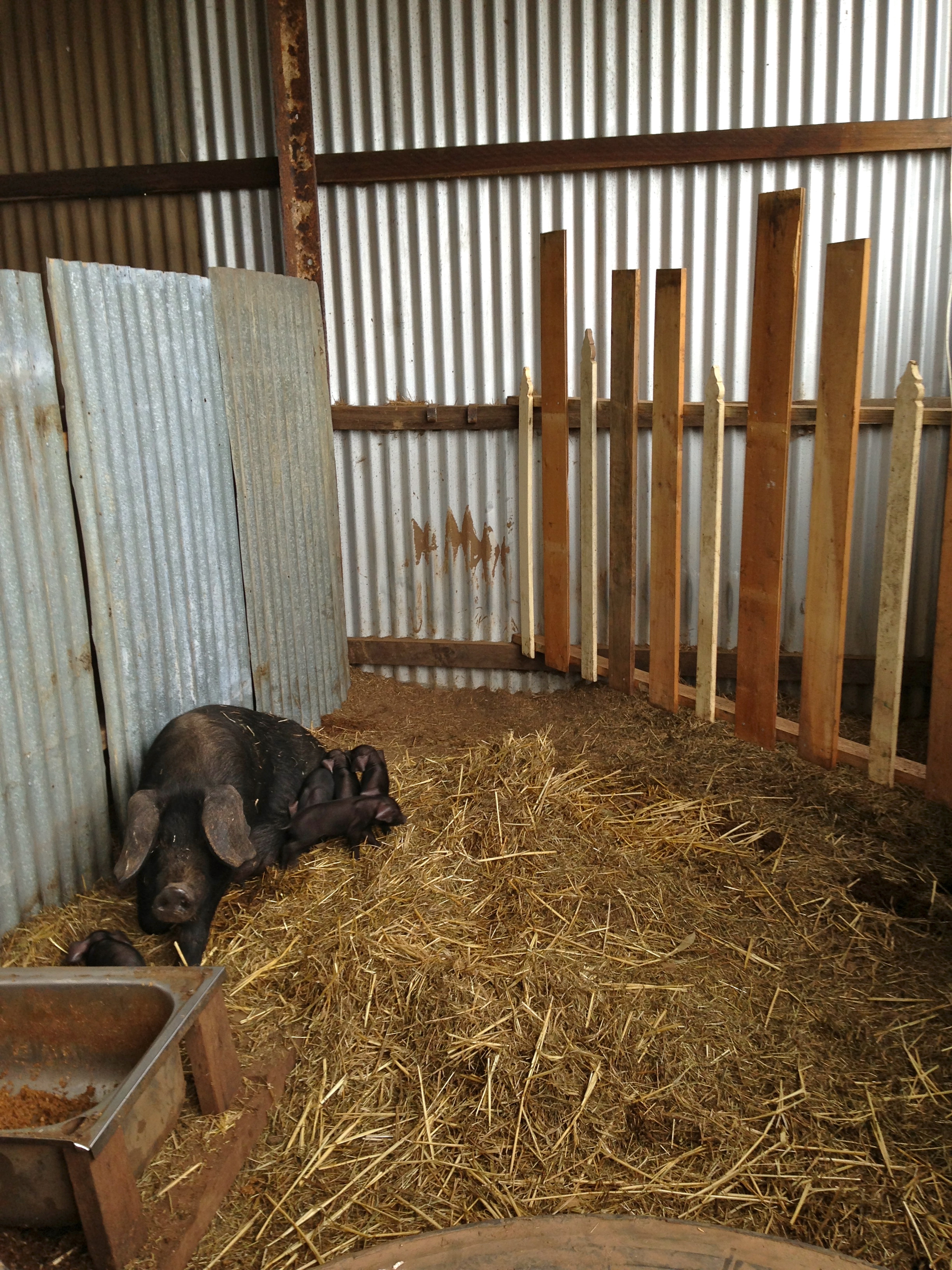 It’s been exciting times around the farm as we welcomed 37 new piglets in five days, though three litters were the result of unplanned teenage pregnancies… yes, that can happen on a free-range pig farm, especially when you don’t castrate. Let me tell you more about our decision to castrate after all…
It’s been exciting times around the farm as we welcomed 37 new piglets in five days, though three litters were the result of unplanned teenage pregnancies… yes, that can happen on a free-range pig farm, especially when you don’t castrate. Let me tell you more about our decision to castrate after all…
As someone concerned about animal welfare, I took it as a given that we wouldn’t castrate, and that the only management strategy we would require for that decision would be to send boars to the abattoir no later than six months old, before they reached sexual maturity. The primary argument against castration is that it causes unnecessary trauma to the pig. The primary arguments in favour of castration are to prevent unwanted pregnancies in the herd, avoid boar taint in the meat, and control undesirable behaviours commonly manifest in boars (aggression against other boars, and occasionally people, though I think this is uncommon amongst well-treated pigs in free-range systems). To my knowledge, most free-range pig farmers do not, as a rule, castrate.
And so we didn’t castrate. What we observed in the paddocks was boars from tiny little piglets through to 60kg growers appearing to ‘play fight’ a fair bit, and to hassle the gilts regularly from a couple months old, including clumsy mating attempts from a young age. They tend to be dominant in the herd, making the gilts less likely to get their fair share of the feed, and if they come together with another young boar from a different family group in another paddock while we move stock, they fight fairly vigorously from about four or five months old. We’ve not had any seriously injured, but torn ears and skin abrasions are common consequences of such aggressive interactions, which also occur around feeding time (amongst gilts and sows too - not just the boars).
When we slaughtered our first pig, I lived in fear of boar taint, as we’d had trouble finding a butcher and had let the pigs grow on to nearly eight months, well past our planned six. The first loin chops had a very mild taint to them, but were still quite delicious. I cooked our Christmas roast for a huge extended family gathering on a bed of aromatics to try to ward it off, and was clearly successful given the reviews that day. The boars we’ve had slaughtered since have been free of taint until the last one, which had a mild case of it, as noted by The Hangry Bitch who came along to Eat Your Ethics during Harvest Week.
Boar taint is a funny thing - not everybody tastes it to the same degree, and allegedly some can’t taste it at all. It can definitely be managed to some extent in the cooking process, or by turning the meat into sausages or salami where lots of other flavours are at play. I am very sensitive to it, which is rather handy as a pig farmer - we taste some of each pig before we sell the meat. I’ve heard stories from other pig farmers of entire carcasses being pulled from sales due to taint - that’s a lot of lost money in expenses to raise and slaughter that pig with no profit in sight, and a very sad outcome to take a life and be unable to serve it at all. (And to confuse matters, it really is a matter of taste, some people like the flavour of boar taint, though few in Australia.)
And then came the pregnant gilts. We keep our pigs in family groups - pigs are very social animals, and have to adjust to new social orders when the groups are mixed. Plus if they’re kept as a litter their feed rations are collectively appropriate for their development stage, and we can easily manage those ready for the abattoir if they’re all in one paddock. Our reading and discussions with other producers had somehow never brought to light the fact that boars can reach sexual maturity as young as four months. The rounding bellies of a few gilts at six months, however, brought it clearly to light.
Not only were they younger than is ideal (younger gilts have smaller litters, and reportedly may not be as good at mothering as if they have their first litter a bit older), we don’t in-breed our pigs - the boar (Borg) and our breeding sows are from different lines. In-breeding is an old practice, and as one of our favourite books (Pig raising in Tasmania, 1966) says, if it’s successful, it’s line breeding, if not, it’s in-breeding! Still we choose to keep our lines separate, except in the case of wayward young boars.
And so we separated out the boars from the gilts, a practice we now do routinely when the pigs are around three months old. At first the boars suddenly fight more, even though they’ve been together. Something about the steadying influence of women, etc. ;-)
Given our experience with boar taint and unplanned pregnancies, we returned to the debate over whether to castrate. This time, of course, we had the benefit of having farmed pigs for over a year, rather than having our inner urban, leftist, idealist glasses on. Okay, I will never take those glasses off except for the inner urban bit, but a year and a half with pigs has taught me that they have an extremely high pain threshold (they’re quite hard on each other when it comes to scrambling for feed, as attested by the number of torn ears in the paddock, no matter how well fed the lovely blighters may be), and that castration would not be any more traumatic than being shoved down the social order by an older sibling when there’s delicious grain to be had.
And that’s the whole story, and why we do now routinely castrate the males. We still don’t vaccinate, and nor do we use sub-therapeutic antibiotics (there’s absolutely no need in a free-range system), and of course we don’t nose ring or dock their gorgeous, curly tails. The sows still farrow in a nice warm, safe stall with fresh straw and a heat lamp to attract the piglets away from cumbersome, dopy new mamas and their lethal squashing accidents, and piglets aren’t weaned until six to eight weeks.
And those barrows (the castrated boars) give a short squeal when they’re cut, antiseptic is applied, and they scamper off as though nothing has happened. I imagine they’re sore, it seems only logical that they would be (as were our cat and dog when they were fixed). But for that period of soreness, they in turn get to have an extra couple of months on the farm, and all within their family groups to the end, as we have been growing our pigs on to seven to eight months with good results.
For us, the trade off is worth it on many levels. Some may disagree with us, and some may think we’re crazy to even tell you the details of management decisions like these, which have real commercial as well as ethical consequences. But we signed up for a transparency model, so that’s what you’ll get, and if you don’t like what we’re doing, please say so, and if we can’t agree, there is surely another system out there that will work for you.
***
If you’re interested in following one of our pigs through his entire life, from birth to Christmas ham, through decisions like whether to castrate, vaccinate, when to rotate through the paddocks, what’s the right feed ratio, and what to do if he gets sick, you can each month with Radio National Bush Telegraph, as Cameron Wilson visits us and gets to know Wilbur 101. He’ll be putting up polls each month where you get to have a say about our management decisions - though we do reserve the right to make the final decision in line with our knowledge and philosophy of what’s best for the pig and the planet.
Oh, and if you really like what we’re doing and why we do it, you might like to support our Pozible project to do our own butchering right here on the farm! We’re 76% funded on day 14 of 40! Thank you to the wonderful, generous ethical omnivores who’ve already supported us! If we go over our target, we’ll be able to put a smokehouse in straight away - the possibilities are endless!


